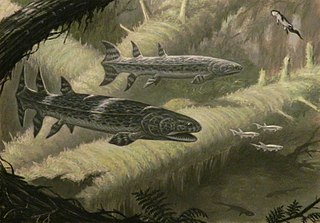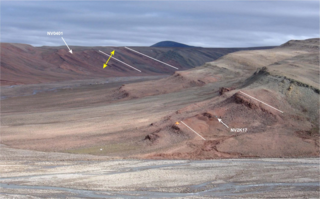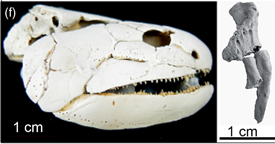
Sarcopterygii — sometimes considered synonymous with Crossopterygii — is a taxon of the bony fishes known as the lobe-finned fishes. The group Tetrapoda, a mostly terrestrial superclass including amphibians, sauropsids and synapsids, evolved from certain sarcopterygians; under a cladistic view, tetrapods are themselves considered a subgroup within Sarcopterygii.

Placodermi is a class of armoured prehistoric fish, known from fossils, which lived from the Silurian to the end of the Devonian period. Their head and thorax were covered by articulated armoured plates and the rest of the body was scaled or naked, depending on the species. Placoderms were among the first jawed fish; their jaws likely evolved from the first of their gill arches.

Panderichthys is a genus of extinct sarcopterygian from the late Devonian period, about 380 Mya. Panderichthys, which was recovered from Frasnian deposits in Latvia, is represented by two species. P. stolbovi is known only from some snout fragments and an incomplete lower jaw. P. rhombolepis is known from several more complete specimens. Although it probably belongs to a sister group of the earliest tetrapods, Panderichthys exhibits a range of features transitional between tristichopterid lobe-fin fishes and early tetrapods. It is named after the German-Baltic paleontologist Christian Heinrich Pander. Possible tetrapod tracks dating back to before the appearance of Panderichthys in the fossil record were reported in 2010, which suggests that Panderichthys is not a direct ancestor of tetrapods, but nonetheless shows the traits that evolved during the fish-tetrapod evolution

Hyneria is a genus of large prehistoric predatory lobe-finned fish which lived in freshwater during the Devonian period (Famennian).

Ventastega is an extinct genus of stem tetrapod that lived during the Upper Fammenian of the Late Devonian, approximately 372.2 to 358.9 million years ago. Only one species is known that belongs in the genus, Ventastega curonica, which was described in 1996 after fossils were discovered in 1933 and mistakenly associated with a fish called Polyplocodus wenjukovi. ‘Curonica’ in the species name refers to Curonia, the Latin name for Kurzeme, a region in western Latvia. Ventastega curonica was discovered in two localities in Latvia, and was the first stem tetrapod described in Latvia along with being only the 4th Devonian tetrapodomorph known at the time of description. Based on the morphology of both cranial and post-cranial elements discovered, Ventastega is more primitive than other Devonian tetrapodomorphs including Acanthostega and Ichthyostega, and helps further understanding of the fish-tetrapod transition.

Cheirolepis is an extinct genus of ray-finned fish that lived in the Devonian period of Europe and North America. It is the only genus yet known within the family Cheirolepidae and the order Cheirolepiformes. It was among the most basal of the Devonian actinopterygians and is considered the first to possess the "standard" dermal cranial bones seen in later actinopterygians.

The Fram Formation is an Upper Devonian (Frasnian) sequence of rock strata on Ellesmere Island that came into prominence in 2006 with the discovery in its rocks of examples of the transitional fossil, Tiktaalik, a sarcopterygian or lobe-finned fish showing many tetrapod characteristics. Fossils of Laccognathus embryi, a porolepiform lobe-finned fish, and Qikiqtania, a close relative of Tiktaalik, were also found in the formation. The Fram Formation is a Middle to Upper Devonian clastic wedge forming an extensive continental facies consisting of sediments derived from deposits laid down in braided stream systems that formed some 375 million years ago, at a time when the North American craton ("Laurentia") was straddling the equator.

Gogonasus was a lobe-finned fish known from three-dimensionally preserved 380-million-year-old fossils found from the Gogo Formation in Western Australia. It lived in the Late Devonian period, on what was once a 1,400-kilometre coral reef off the Kimberley coast surrounding the north-west of Australia. Gogonasus was a small fish reaching 30–40 cm (1 ft) in length.

Lunaspis is an extinct genus of armor-plated petalichthyid placoderm fish that lived in shallow marine environments of the Early Devonian period, from approximately 409.1 to 402.5 million year ago. Fossils have been found in Germany, China and Australia. There are three different identified species of within the genus Lunaspis: L. broilii, L. heroldi, and L. prumiensis.

Onychodus is a genus of prehistoric lobe-finned fish which lived during the Devonian period. It is one of the best known of the group of onychodontiform fishes. Scattered fossil bones of Onychodus were first discovered in 1857, in North America, and described by John Strong Newberry. Other species were found in Australia, England, Norway and Germany showing that it had a widespread range.

Porolepiformes is an order of prehistoric lobe-finned fish which lived during the Devonian period. They are thought to represent the sister group to lungfish. The group contains two families: Holoptychiidae and Porolepididae.
Canowindra is a prehistoric lobe-finned fish which lived during the Late Devonian period. The genus is known from only a single well preserved specimen, dubbed Canowindra grossi, after Professor Walter Gross, who spent his career studying lobe-finned fish, and after the Australian town in which it was found, Canowindra. Canowindra grossi was apparently comparatively small in size and belongs to the family of Canowindridae.

Laccognathus is an extinct genus of amphibious lobe-finned fish from Europe and North America. They existed from the Middle Devonian to the Late Devonian. The name comes from Greek for 'pitted jaw'.

Laccognathus embryi is an extinct species of porolepiform lobe-finned fish recovered from Ellesmere Island, Canada. It existed during the Frasnian age of the Late Devonian epoch.

Laccognathus panderi is an extinct lobe-finned fish from northern Europe. They existed from the Middle Devonian to the Late Devonian.

The Gauja Formation is a Middle Devonian fossil locality in Estonia and Latvia. It is named after the Gauja River, where it is exposed along the banks.

The evolution of fish began about 530 million years ago during the Cambrian explosion. It was during this time that the early chordates developed the skull and the vertebral column, leading to the first craniates and vertebrates. The first fish lineages belong to the Agnatha, or jawless fish. Early examples include Haikouichthys. During the late Cambrian, eel-like jawless fish called the conodonts, and small mostly armoured fish known as ostracoderms, first appeared. Most jawless fish are now extinct; but the extant lampreys may approximate ancient pre-jawed fish. Lampreys belong to the Cyclostomata, which includes the extant hagfish, and this group may have split early on from other agnathans.

Ptyctodus is an extinct armour-plated fish of the late Devonian. Ptyctodus belongs to the family Ptyctodontidae and is of the class Placodermi. They share a close resemblance to modern day chimaeras (Holocephali). Fossils of this armour-plated fish have been found in locations such as in Russia, the Michigan Basis, and Arizona, United States.
Heightingtonaspis is an extinct genus of primitive arthrodire placoderm from Canada, England and Wales with two species previously allied with the genus Kujdanowiaspis.















